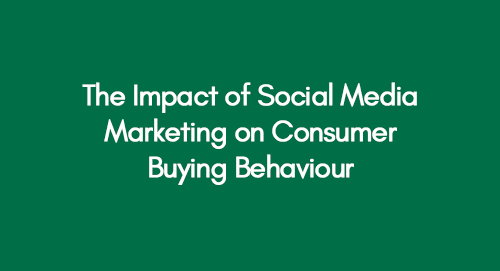
Luxury Marketing and Branding- An Evaluation under BLI (Brand Luxury Index)
June 1, 2022
Challenges Entrepreneurs Face While Implementing Advanced Biomedical Technology in Healthcare: The Case Study of UK
June 1, 2022 Download PDF File
Download PDF File
Investigating how social media affects what people buy by studying M&S in the UK. This research looks at how social media marketing influences shoppers at M&S. In a global and competitive market, many organisations are adopting digital marketing methods to attract diverse customers and consumers.
Introduction
The study by Chaffey and Smith (2017) states that digital marketing is an effective technique to improve sales and engage with customers cost-effectively. Furthermore, digital marketing also provides several opportunities for brands to grow their presence on a global stage and gain prosperity.
Impact of Digital Marketing in Generating High Customer Base of Online Retailers
Similarly, different brands in the UK are also adopting digital marketing techniques to influence consumers' buying behaviours (Chaffey and Ellis-Chadwick, 2019). Therefore, this research will study the digital marketing techniques used by M&S to impact the procuring decisions of their customers. Briefly, this research tends to evaluate the impact of social media marketing on consumer buying behaviour. According to the study by Baltes (2015), social media and content marketing are the most imperative characteristics of digital marketing that enable brands to analyse the purchase intentions of their buyers effectively.
According to Nizar and Janathanan (2018), consumer buying is based on social, psychological, and personal factors.
Theoretical Background and Research Focus
The study by Pappas (2016) states that consumer buying behaviour and processes assist organisations and brands in identifying their market niche. Furthermore, the study of Felix, Rauschnabel and Hinsch (2017) discusses that through SMM strategies, brands can identify the process and journey of consumer buying behaviour from recognition to purchase.
Website Attributes on Consumer Buying Pattern
A consumer's buying process is often influenced by various factors such as economic conditions, buying power, and personal likes or dislikes. However, the study of Ashley and Tuten (2015) states that social media can impact consumers' buying behaviour by utilising the power of content creation. Content creation is a method which is used creatively to gain interest from customers and engage them with a specific product. Furthermore, the study by Baltes (2015) also mentions that content creation assists the buyer in the purchasing process and provides a certain level of engagement with the brand. Therefore, this research focuses on assessing the impact of social media marketing on consumer buying behaviour by analysing the case of M&S. According to the study by Dwivedi, Kapoor and Chen (2015), different retail brands are now using digital marketing methods to connect with consumers and increase their product sales.
Problem Statement
According to the study by Kannan (2017), major organisations now focus on building customer relationships on digital platforms. Therefore, a study regarding DM and its influence on consumer buying behaviour is becoming a necessity (Shaw, 2018). Another study by Chaffey and Smith (2017) highlights that a major aspect of digital marketing influencing consumers' buying behaviour is social media. However, the problem identified in this study is that the literature regarding the effect of SM is limited. Similarly, according to the study by Baltes (2015), content creation and advertisements are known as the most influential tools and techniques present in the concept of digital marketing. Therefore, the main focus of this research is to understand the works of literature associated with social media and digital marketing.
The study will focus on past research and will use appropriate methodologies that apply to this study. Moreover, combining studies from different authors and researchers will bridge the literature gap regarding digital marketing and create opportunities for researchers and organisations to study the impact of social media marketing on consumer buying behaviour The study of Järvinen (2016) mentions that analysis regarding the field of DM is required to study its influence on buying behaviour effectively. Furthermore, the content creation and marketing study significantly lacks academic research because the topic is constantly evolving and maturing (Baltes, 2015).
Justification and Contextualisation
In a globally competitive and digitally-enabled market today, invariably, the footprint of digital outreach has enhanced, where consumers increasingly prefer to experience and buy products online (Dasgupta and Grover, 2019). During the past two decades, organisations have swiftly transitioned from traditional marketing to the new digital marketing landscape. Consumer choices and preferences are changed by digital marketing (Rasool, 2015). World over and especially in developed countries like the United Kingdom, where the internet and other digital platforms are abundant, consumers are exposed to many quality products and online services.
Guidelines for Composing a Social Media Marketing Dissertation
In light of the previous comments by Dasgupta and Grover (2019), the study aims to identify, analyse and evaluate the imprint of digital marketing on consumer behaviour. It is pertinent to assess the factors associated with the impact of social media marketing on consumer buying behaviour and their decision-making process, ultimately altering consumer buying behaviour. Mahalaxmi and Ranjith (2016) argue that new communication tools have emerged with the development of new technologies, which here can be termed digital marketing. They point out that digital channels now being used to sell products include social media platforms, for instance, Facebook, Instagram and similar social networks, and the companies' websites.
Hypothesis
As evidenced by the literature and research, the impact created by digital marketing on consumer behaviour needs to be empirically assessed. In line with this, the proposed research draws the following hypotheses:
- H1: SMM and content marketing lead to increased sales.
- H2: SMM and content marketing create consumer loyalty.
Aim and Objectives
The research aims to analyse the impact of digital marketing on consumer buying behaviour focusing on the case study of M&S in the UK.
- To identify the benefits of social media marketing on consumer behaviour.
- To determine the impact of social media marketing and content creation on consumer behaviour.
- To assess the challenges of social media marketing faced by Marks and Spencer (M&S).
- To provide recommendations for future social media marketing strategies related to Consumer Behaviour.
Research Questions
The research questions that this study will attempt to answer are as follows:
- What are the benefits of social media marketing and content creation on consumer behaviour?
- What impact do social media marketing and content creation have on consumer behaviour?
- What are the challenges of social media marketing faced by Marks and Spencer (M&S)?
- What can future social media marketing strategies related to consumer behaviour be opted for by M&S?
Outline of the Study
Chapter 1 of this proposal briefly introduces the topic and highlights the impact of digital marketing on consumer buying behaviour Furthermore, chapter 1 also includes the theoretical background and the focus of the research. This section provides detailed background knowledge and the focus of this research. While the problem statement section identifies the underlying research gap, the justification and contextualisation section descriptively provides an explicit purpose of the research. Chapter 1 also provides the hypothesis of the study. Moreover, the aims and objectives of this research define the purpose of this research. Research questions are also developed by using the aims and objectives.
Furthermore, chapter 2 of the literature review provides a detailed discussion of consumer decision-making and buying behaviour. Moreover, the literature review also discusses the digital marketing techniques used by M&S to influence consumers' buying behaviour. Furthermore, chapter 3 of this proposal describes the research methodology that will be applied in the research. Therefore, the methodology section descriptively discusses the research philosophy, approach, and design used in this study. Furthermore, the methodology also provides details of the sampling method, technique, and size. Moreover, data collection and data analysis methods are also discussed. Besides, the methodology also highlights the research limitations and ethical considerations. Furthermore, chapter 4 of this study will focus on the thematic analysis for this research. Moreover, chapter 5 of this study will conclude the study and offer proper recommendations for the future strategies of digital marketing that influence consumer behaviour.
Literature Review
The study by Grover and Dasgupta (2019) highlights that digital marketing is critical in influencing product sales today. Similarly, according to the study by Shaw (2018), brands often use different digital marketing strategies and methods to attract customers and create brand loyalty among them. Among various aspects of DM, SMM and content creation are the most effective techniques used to attract customers Kannan (2017). According to the study by Ashley and Tuten (2015), consumers' buying behaviour can be subjected to different social media channels. Various brands now offer shopping services on social media websites such as Facebook and Instagram (Zhu and Chen, 2015). Companies and brands use social websites to attract customers by creating engaging content in videos, podcasts, images, and online surveys. A study by Alalwan et al. (2017) mentions that brands can reach a diverse range of customers and consumers across the globe by marketing their products on different social media channels. As per the study by Dahl (2018), social media has a substantial global reach, and brands are using different approaches to capitalise on the medium.
However, the study of Stephen (2016) argues that even though social media is a competent tool to attract customers, consumers often get influenced by their buying processes. Furthermore, the study of De Mooij (2019) also states that consumer buying behaviour is often influenced by experiences gained from their environments. A study by Murphy and Dweck (2016) states that the purchasing behaviour of consumers is based on their emotions and reasoning. The economic situation of a country or a market is more likely to influence the purchasing behaviour of consumers. Taufique et al. (2016) study suggests that consumers are more confident in buying and purchasing decisions in a favourable economic environment. Similarly, personal preferences, values, likes, and dislikes are also crucial factors influencing consumers' buying behaviour. According to Godey et al. (2016), social media campaigns and content might influence purchasing behaviour but likes and dislikes are more influential in determining whether to buy.
A study by Järvinen and Taiminen (2016) discusses that engaging content can influence consumer buying. Content creation can be in the form of advertisements and videos that catch the audience's attention and influence their buying behaviour (Kee and Yazdanifard, 2015). Similarly, social media posts and content that can connect with personal, social, and psychological areas of buying behaviour can generate increased sales. According to the study by Pažėraitė and Gedvilaitė (2016), the impact of engaging content can influence the social factor of buying behaviour among consumers. Furthermore, influencing each consumer buying process from need recognition to post-purchase evaluation often guarantees an increased return on investment (Andaç, Akbiyuk and Karkar, 2016). Different social media tools and techniques can engage with the customer constantly, resulting in increased interest levels among buyers and consumers (Kilgour, Sasser and Larke, 2015). Reviews from social media connections and influencers are also essential in impacting the buying processes of consumers (Grover and Dasgupta, 2019). A study by (Khamis, Ang and Welling (2017) mentions that SM influencers have a robust following on different social mediums and mentioning a specific brand can increase sales and following of that particular brand.
In light of the facts mentioned above, the study will focus on the case of Marks & Spencer’s (M&S), one of the biggest and most affluent retailers in the UK. This will help to understand the practical implications of digital marketing and the way it helps to influence consumer behaviour. M&S Strategic Report (2019) suggests that it has made significant progress in digital marketing and has focused on the shopping content on its website and thereby has made a conscious effort to improve its e-commerce. The digital marketing turnover started when M&S moved away from the Amazon platform to completely revamp the website, digital tablet, and mobile application. The M&S Strategic Report (2019) agrees that the digital capabilities of M&S have, in the past, been unable to keep at par with digital marketing. Therefore special attention is being paid to improving online consumer experience and digital outreach.
Methodology
Research methodology often comprises the following elements:
Research Philosophy
Research philosophy often adheres to research's primary and pragmatic needs (Pham, 2018). This study will utilise the pragmatism paradigm because it aims to view objects and subjective research assessments. According to the study by Stuhr (2015), pragmatic philosophy refers to the mix of different philosophies with objective and subjective interpretations. Pragmatism philosophy will be used because the study comprises consumer behaviour and its change regarding digital marketing. It will seek the opinion of the consumers and the Digital Marketing Managers.
According to Hashemnezhad (2015), there are two methods to express ‘reason’, consisting of the inductive and deductive approaches.
Research Approach
The inductive approach is to reach the general from more specific research, while the deduction starts with the more general and ends with the specific. This research will utilize the deductive approach since the research will seek the opinions of the consumers and managers to determine the impact of DM on customer behaviour, so the theory of positivism will be implicated. Rubin and Rubin (2011) mention that naturalistic researchers come with the presumption that reality is not stagnant but constantly evolving. This can only be known and understood indirectly, using interpretations from people with different perspectives of the truth.
Research Design
The main categorizations of research design are either qualitative or quantitative. Rahman (2017) points out that the qualitative approach is based on constructivism, referring to gathering non-numeric data. This type of data may be collected from various sources previously available in the research domain, for instance, research studies and literature reviews. The quantitative research design primarily seeks statistical data analysis to establish a connection between the known factors and ones discovered during the study. The proposed methodology for this research will be a mixed-methods approach, where both qualitative and quantitative designs go parallel to reach the empirical conclusion, as it is often seen as a rigorous methodology to meet the objective and subjective ends of the research. Zohrabi (2013) affirms that when the main instruments used in mixed-method research consist of closed or open-ended questionnaires, interviews, and observations, these different methods of gathering and acquiring information need to supplement each other to enhance the validity and dependability of the data significantly.
Sampling Method, Technique, and Size
Ott and Longnecker (2015) argue that researchers should draw representatives or Specific samples from the target population with similar characteristics for the research purpose. The sampling methods mainly comprise a) probability and b) non-probability. While within the non-probability sampling, there is a convenience sampling technique. This study will utilize convenience sampling to convene this examination. Convenience sampling is an appropriate technique as it permits the researcher to collect the data while considering the times and resource constraints (Etikan et al., 2016). In this study, 100 consumers exposed to digital marketing with ten managers from M&S are the potential research participants, who will respond to the research queries set forth by the examiner. The total sample size for the research will be 110 participants, where 100 consumers will be surveyed through a questionnaire, and 10 Managers will participate in the individual interviews designed for the participants.
Data Collection Methods
Primary and secondary data collection methods will be used in the study. The data gathered firsthand or new in totality; is collected through primary methods, for instance, interviews, surveys, and questionnaires. Furthermore, if the data is available in previous research studies and databases, e.g. journals, articles, publications, and other online sources, it may be collected through secondary sources. Lampard and Pole (2015) suggest that the collected data should be adequate and under the data analysis requirements for authentic and rigorous results. This research proposal will use a mixed methodology, whereby data will be collected from the mentioned sources.
Data Analysis
The study will apply mixed-method data through open/close-ended questionnaires and interviews. For the quantitative data, the researcher will use different statistical tests, including regression and correlation, to assess the relationship between the variables analytically. In contrast, SPSS will help reach a meaningful conclusion. The qualitative data will be collected through interviews with the research participants. For this purpose, common themes will be derived from within the responses, with the help of the thematic analysis.
Research Limitations
The proposed research study has certain limitations, which will be taken into account by the Researcher. Only a limited number of Managers and consumers can be surveyed and interviewed because of the demographical, geographical, time, and resource constraints. Furthermore, the transformation of data is also required for the integration of mixed data during data analysis. The research was also limited because the inequality between both methods would result in inadequate data for the study, which can be damaging to the results.
Ethical considerations are crucial to any research study.
Ethical Considerations
The researcher exercises ethical considerations while conducting this research. Before collecting responses from the research participants through structured/semi-structured interviews, a consent form will be designed to ensure voluntary participation from the respondents. The research participants and their respective responses are kept confidential at all times to allow their independent opinions to be reflected. The data will remain confidential in this study, and the participant information will be kept anonymous. The research participants have a choice to withdraw from the research at the time of choosing without any prior terms or conditions. Lastly, during the research, participants will be kept aware of these ethical practices and their rights, as granted by the researcher.
Review the Following:

References
Alalwan, A.A., Rana, N.P., Dwivedi, Y.K. and Algharabat, R., 2017. Social media in marketing: A review and analysis of the existing literature. Telematics and Informatics, 34(7), pp.1177-1190.
Andaç, A., Akbiyuk, F. and Karkar, A., 2016. Customer satisfaction factor in digital content marketing: Isparta Province as an example. Int'l J. Soc. Sci. Stud., 4, p.124.
Ashley, C. and Tuten, T., 2015. Creative strategies in social media marketing: An exploratory study of branded social content and consumer engagement. Psychology & Marketing, 32(1), pp.15-27.
Baltes, L.P., 2015. Content marketing is a fundamental tool of digital marketing. Bulletin of the Transilvania University of Brasov. Economic Sciences. Series V, 8(2), p.111.
Chaffey, D. and Ellis-Chadwick, F., 2019. Digital marketing. Pearson UK.
Chaffey, D. and Smith, P.R., 2017. Digital marketing excellence: planning, optimizing and integrating online marketing. Taylor & Francis.
Dahl, S., 2018. Social media marketing: Theories and applications. Sage.
Dasgupta, S. and Grover, P., 2019. Impact of digital strategies on consumer decision journey: special. Academy of Marketing Studies Journal.
De Mooij, M., 2019. Consumer behaviour and culture: Consequences for global marketing and advertising. SAGE Publications Limited.
Dwivedi, Y.K., Kapoor, K.K. and Chen, H., 2015. Social media marketing and advertising. The Marketing Review, 15(3), pp.289-309.
Etikan, I. and Bala, K., 2017. ‘Sampling and sampling methods’, Biometrics and amp; Biostatistics International Journal, 5(6), pp. 149
Felix, R., Rauschnabel, P.A. and Hinsch, C., 2017. Elements of strategic social media marketing: A holistic framework. Journal of Business Research, 70, pp.118-126.
Godey, B., Manthiou, A., Pederzoli, D., Rokka, J., Aiello, G., Donvito, R. and Singh, R., 2016. Social media marketing efforts of luxury brands: Influence on brand equity and consumer behaviour. Journal of business research, 69(12), pp.5833-5841.
Gray, D. (2014). Doing research in the real world. 3rd edition. London: SAGE
Hashemnezhad, H., 2015. Qualitative content analysis research: A review article. Journal of ELT and applied linguistics (JELTAL), 3(1), pp.54-62.
Järvinen, J. and Taiminen, H., 2016. Harnessing marketing automation for B2B content marketing. Industrial Marketing Management, 54, pp.164-175.
Järvinen, J., 2016. The use of digital analytics for measuring and optimizing digital marketing performance. Jyväskylä studies in business and economics, (170).
Kannan, P.K., 2017. Digital marketing: A framework, review and research agenda. International Journal of Research in Marketing, 34(1), pp.22-45.
Kee, A.W.A. and Yazdanifard, R., 2015. The review of content marketing as a new trend in marketing practices. International Journal of Management, Accounting and Economics, 2(9), pp.1055-1064.
Khamis, S., Ang, L. and Welling, R., 2017. Self-branding, ‘micro-celebrity and the rise of Social Media Influencers. Celebrity studies, 8(2), pp.191-208.
Kilgour, M., Sasser, S.L. and Larke, R., 2015. The social media transformation process: curating content into strategy. Corporate Communications: An International Journal, 20(3), pp.326-343.
Lampard, R. and Pole, C., 2015. Practical social investigation: Qualitative and quantitative methods in social research. Routledge
Mahalaxmi, K.R. and Ranjith, P., 2016. A Study on Impact of Digital Marketing on Customer Purchase Decision in Trichy. International Journal for Innovative Research in Science & Technology, 2(10), pp.332-338.
Murphy, M.C. and Dweck, C.S., 2016. Mindsets shape consumer behaviour. Journal of Consumer Psychology, 26(1), pp.127-136.
Nizar, N.A. and Janathanan, C., Impact of digital marketing on consumer purchase behaviour.
Ott, R.L. and Longnecker, M.T., 2015. An introduction to statistical methods and data analysis. Nelson Education.
Pappas, N., 2016. Marketing strategies, perceived risks, and consumer trust in online buying behaviour. Journal of Retailing and Consumer Services, 29, pp.92-103.
Pažėraitė, A. and Gedvilaitė, R., 2016. Content marketing elements and their influence on search advertisement effectiveness: theoretical background and practical insights. Organizacijų vadyba: sisteminiai tyrimai. Kaunas: Vytauto Didžiojo universitetas, 2016,[T.] 75.
Pham, L.T.M., 2018. A Review of Key Paradigms: Positivism. Interpretivism & Critical Inquiry, School of Education, The University of Adelaide.
Rahman, M.S., 2017. The Advantages and Disadvantages of Using Qualitative and Quantitative Approaches and Methods in Language" Testing and Assessment" Research: A Literature Review. Journal of Education and Learning, 6(1), pp.102-112.
Rasool, M.G., 2015. Consumer’s Behavior and Effectiveness of Social Media. Global Journal of Management and Business Research, 14(8).
Rubin, H.J. and Rubin, I.S., 2011. Qualitative interviewing: The art of hearing data. Sage.
Shaw, A., 2018. Digital marketing trends that are changing the way we market to consumers. Website] Abruf [24.01. 2019] unter: https://www. forbes. com/sites/Forbes communications council/2018/08/29/digital-marketing-trends-that-are-changing-the-way-we-market-to-consumers.
Stephen, A.T., 2016. The role of digital and social media marketing in consumer behaviour. Current Opinion in Psychology, 10, pp.17-21.
Strategic Report. (2019). [online] Marks and Spencer. Available at: https://corporate.marksandspencer.com/documents/msar-2019/strategic-report.pdf [Accessed 18 Feb. 2020].
Stuhr, J.J., 2015. Pragmatism, postmodernism and the future of philosophy. Routledge.
Taufique, K.M.R., Siwar, C., Chamhuri, N. and Sarah, F.H., 2016. Integrating general environmental knowledge and eco-label knowledge in understanding ecologically conscious consumer behaviour. Procedia Economics and Finance, 37, pp.39-45.
Zhu, Y.Q. and Chen, H.G., 2015. Social media and human need satisfaction: Implications for social media marketing. Business Horizons, 58(3), pp.335-345.
Zohrabi, M., 2013. Mixed Method Research: Instruments, Validity, Reliability and Reporting Findings. Theory & practice in language studies, 3(2).
Interview Questions
In your opinion why do you think that digital marketing is capable of attracting customers?
As a Marketing Manager do you consider content creation and social media marketing as an operative method of communication with the consumers?
As a consumer do you get influenced by the quality of content used for marketing by the brands?
How is M&S preparing to innovate its marketing strategies to attract consumers with its social media content?
What is the specific thing that attracts you or catches your attention as a consumer which influences your buying behaviour?
What are the particular strategies which you as a Marketing Manager think are important in Digital Marketing?
Do you prefer shopping online or in physical stores?
How much influence does content marketing and social media marketing have on consumer buying behaviour?
Do you prefer buying products from brands that are active on social media and produce engaging content?
Is social media marketing considered a key factor in improving product sales and reaching consumers?
Get 3+ Free Dissertation Topics within 24 hours?



























